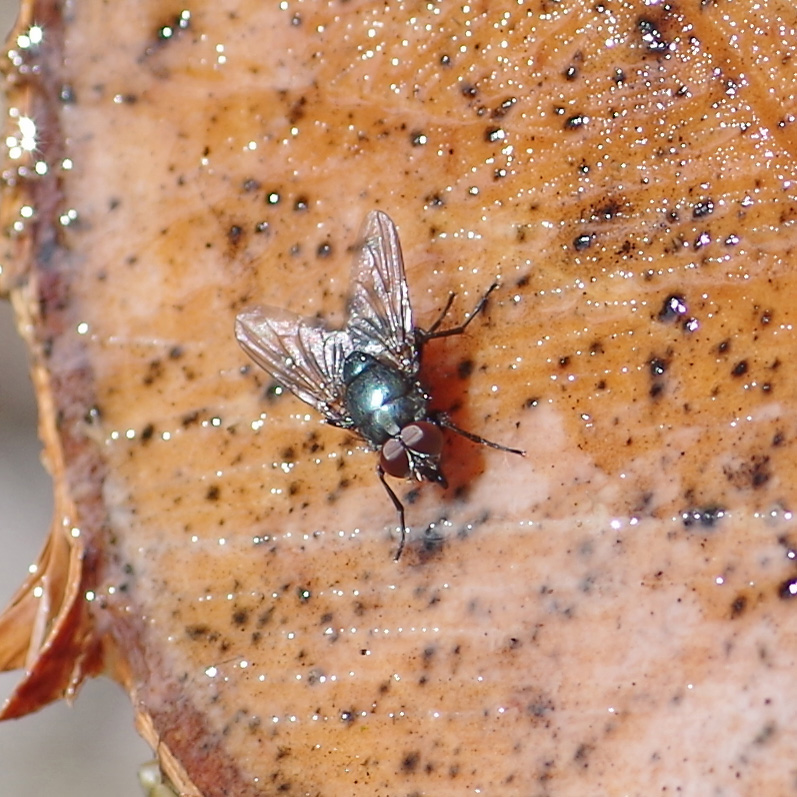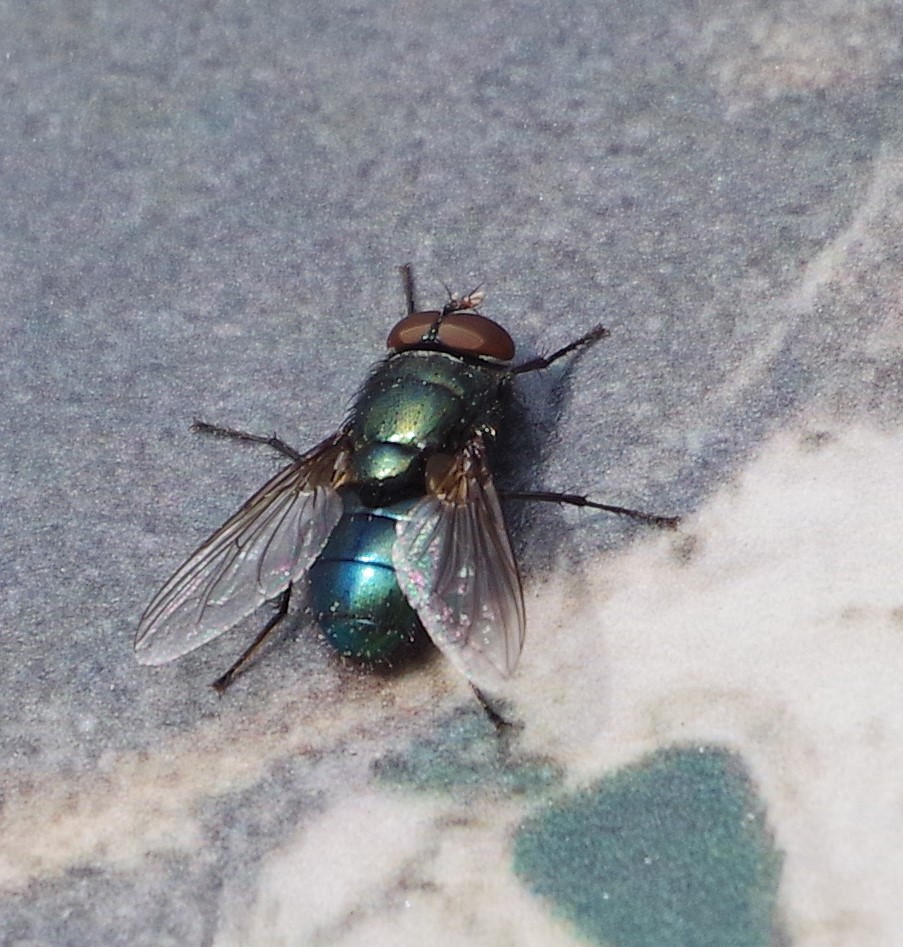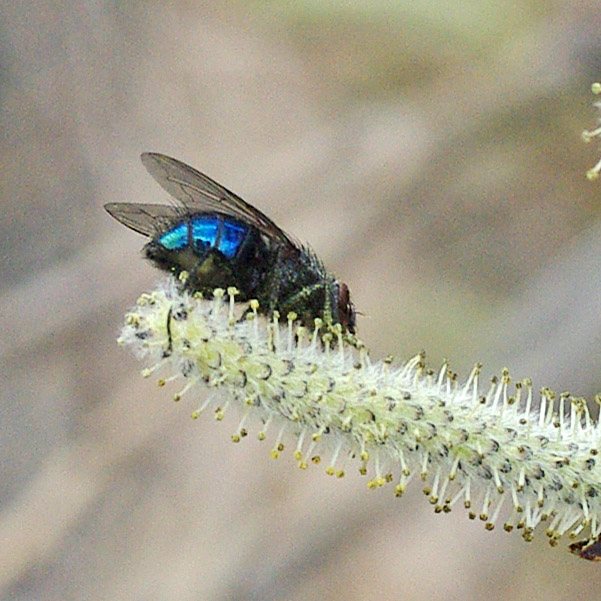
Black Blow fly
The BugLady has been stewing about this one for a long time. The flies appear on cue, on mild days in March and April (which they can do because they overwinter as adults). She takes their pictures, gets bogged down identifying them, and files them generically under “bluebottle flies.” The reason for her confusion is that there are similar species in several genera of several subfamilies of the Blow fly family:
This year, the BugLady has decided that it’s time to fish or cut bait, so she’s calling them Black blow flies and getting on with her life.
The family Calliphoridae (Blow flies) includes Carrion flies, Blow flies, Bluebottle and Greenbottle flies, Cluster flies, and the notorious Screwworm flies. These often-metallically-colored flies are common in many habitats around the world, including urban areas, where they bask on sunny walls. The name Blow fly (which was coined by William Shakespeare) comes from an old English term for meat that flies have laid eggs in – such meat was said to be “fly blown.”
Most Calliphorid larvae (maggots) make their living as recyclers, which conjures up a more wholesome image than does saprophagous (feeding on decaying organic material) or sarcosaprophagous (“feeding on decaying animal material”) (to complete the set, scato/coprophagous refers to feeding on excrement and phytosaprophagous to feeding on rotting plant material. Quadruple word scores all around). Maggots eat dung and/or carrion, excreting proteolytic enzymes that break down its proteins, and a few species are parasites.
Adult blow flies get carbs from nectar and are minor pollinators (they’re attracted to flowers with strong, “meaty,” odors), but they also visit carrion and dung to get protein. The BugLady photographed one fly as it fed on sap that was leaking from the cut trunk of a small tree in early spring.
In a blog post titled “Ten reasons why blow flies are stink’n awesome” from the Insect Ecology and Communication Lab at Ohio University, the author writes, “……All joking aside though, blow flies don’t really smell, it’s the resources they are associated with (garbage, poop, carrion, etc.) that smells. The purpose of this post is to make you fall in love with appreciate blow flies! Blow flies are considered filth flies because they are a terrible nuisance to people and are thought of as disease vectors. Overall, blow flies have a bad reputation because of their less than socially approved eating habits (the BugLady is not going to list the ten – read the article https://bekkabrodie.com/2014/05/20/ten-reasons-why-blow-flies-are-stinkn-awesome/). On the negative side – you know where that mouth and those feet have been. On the plus side – they don’t bite.
Experienced BugFans can see where this is going. The BugLady will try to tell the story as delicately as possible, but this lifestyle is just a part of the magnificent panoply that is the insect world and, well – blow flies happen.


THE BLACK BLOW FLY (Phormia regina), the only species in its genus, is a cold-loving fly that can be found across North America and around the world, especially in rural areas near water. It’s seen more commonly during spring and fall in the northern half of its range, and in winter in the southern half. In an article in the Martha’s Vineyard Times, Matt Pelikan (who writes nice natural history articles) says “Nobody seems to know where it originated; perhaps it had succeeded in colonizing much of the globe on its own even before human commerce began transporting wildlife from continent to continent. Or perhaps Phormia began hitching rides so early on in human history that it was already established most places by the time the first biologists turned up and began looking at flies.”
Both male and female Black blow flies need protein to fuel their mating and reproductive activities, and they get this protein from dung, which they ingest via “sponging” mouthparts.
Adults emerge from their winter shelters under tree bark and fallen leaves (sometimes putting in an appearance during a January thaw), and when the air warms consistently to about 50 degrees, the dance begins. In the case of Black blow flies, the singles scene revolves around animal droppings, and males with larger hat sizes tend to be more successful at getting the gals. After mating, the female “sniffs” the air, and tracks down some carrion. Although adults get their nutrients from animal droppings, their eggs are laid on dead meat (up to 250 eggs, in various nooks and crannies).
The eggs hatch quickly in their meaty substrate; they have three instars (the eating stages between molts), and a feeding, metabolizing mass of third-stage maggots generates so much heat that the temperature within the mass can be 50 degrees F (or more) warmer than the ambient temperature. It’s called the “maggot mass effect,” and it not only keeps everyone toasty, it gooses development and protects against predators and parasites. The larvae survive the stress of this shot of heat by creating “heat shock proteins” (the BugLady was going to attempt a brief explanation of heat shock proteins, but she got into deep water pretty fast). Maggots leave the nursery carcass and form pupal cases on the ground; their run from egg to pupa can be as brief as 6 days, with an additional week in the pupal case, but in cooler temperatures they may take up to 12 days longer to mature. The faster their development is, the smaller the adults are.
Sources disagreed about whether Black blow flies routinely come inside (most say no), but one suggested that if you see a cluster of blow flies in/around the house, they might be attracted to the odor of a gas leak.
Black blow flies are exquisitely sensitive to the smell of a recently dead animal. They are among the first to arrive at the scene, which is why they are favorites of the CSI folks and why their chronologies have been so minutely charted.
Another service provided by a number of blow flies, including the Black blow fly, is wound care (called biotherapy or maggot therapy). Super-clean maggots are applied to open wounds with stubborn infections because those proteolytic enzymes break down the necrotic tissue for the maggots to eat and leave the healthy tissue alone. Pick your blow flies carefully – some species (but not this one) sweeten the pot by adding antibiotic secretions to the wound, and other species will feed on healthy tissue. Unwanted maggot infestations are called myiasis, and they happen to livestock (mostly), in warmer climes (mostly).
Final Cool Fact about Blow Flies, from the Insect Ecology and Communication Lab “Blow flies are able to fly with such precision that we are never able to swat them. This is because of the very tiny second pair of wings called halteres, which function like mini gyroscopes and help the fly to calculate in flight maneuver instantly. Scientists use Blow flies to study flight muscles and split second flight maneuvers. They have discovered flies in mid-turn have the ability to roll on their sides 90º or more (flying upside down) just like a jet fighter.”
According to a 1922 report of the Kansas State Board of Health, “The robin and the bluebottle fly are the early harbingers of spring.”
Kate Redmond, The BugLady
Bug of the Week archives:
http://uwm.edu/field-station/category/bug-of-the-week/
